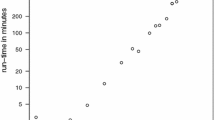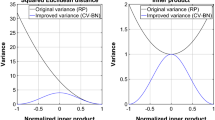Abstract
Control variates are used as a variance reduction technique in Monte Carlo integration, making use of positively correlated variables to bring about a reduction of variance for estimated data. By storing the marginal norms of our data, we can use control variates to reduce the variance of random projection estimates. We demonstrate the use of control variates in estimating the Euclidean distance and inner product between pairs of vectors, and give some insight on our control variate correction. Finally, we demonstrate our variance reduction through experiments on synthetic data and the arcene, colon, kos, nips datasets. We hope that our work provides a starting point for other control variate techniques in further random projection applications.
Access this chapter
Tax calculation will be finalised at checkout
Purchases are for personal use only
Similar content being viewed by others
References
Achlioptas, D.: Database-friendly random projections: Johnson-Lindenstrauss with binary coins. J. Comput. Syst. Sci. 66(4), 671–687 (2003). https://doi.org/10.1016/S0022-0000(03)00025-4
Ailon, N., Chazelle, B.: The fast Johnson-Lindenstrauss transform and approximate nearest neighbors. SIAM J. Comput. 39(1), 302–322 (2009). https://doi.org/10.1137/060673096
Alon, U., Barkai, N., Notterman, D., Gish, K., Ybarra, S., Mack, D., Levine, A.: Broad patterns of gene expression revealed by clustering analysis of tumor and normal colon tissues probed by oligonucleotide arrays. Proc. Nat. Acad. Sci. 96(12), 6745–6750 (1999)
Boutsidis, C., Gittens, A.: Improved matrix algorithms via the subsampled randomized hadamard transform. CoRR abs/1204.0062 (2012). http://arxiv.org/abs/1204.0062
Boutsidis, C., Zouzias, A., Drineas, P.: Random projections for k-means clustering. In: Lafferty, J.D., Williams, C.K.I., Shawe-Taylor, J., Zemel, R.S., Culotta, A. (eds.) Advances in Neural Information Processing Systems 23, pp. 298–306. Curran Associates, Inc. (2010). http://papers.nips.cc/paper/3901-random-projections-for-k-means-clustering.pdf
Fern, X.Z., Brodley, C.E.: Random projection for high dimensional data clustering: a cluster ensemble approach, pp. 186–193 (2003)
Guyon, I., Gunn, S., Ben-Hur, A., Dror, G.: Result analysis of the NIPS 2003 feature selection challenge. In: Saul, L.K., Weiss, Y., Bottou, L. (eds.) Advances in Neural Information Processing Systems 17, pp. 545–552. MIT Press (2005). http://papers.nips.cc/paper/2728-result-analysis-of-the-nips-2003-feature-selection-challenge.pdf
Kang, K., Hooker, G.: Random projections with control variates. In: Proceedings of ICPRAM, February 2016
Li, P., Church, K.W.: A sketch algorithm for estimating two-way and multi-way associations. Comput. Linguist. 33(3), 305–354 (2007). https://doi.org/10.1162/coli.2007.33.3.305
Li, P., Hastie, T.J., Church, K.W.: Improving random projections using marginal information. In: Lugosi, G., Simon, H.U. (eds.) COLT 2006. LNCS (LNAI), vol. 4005, pp. 635–649. Springer, Heidelberg (2006). https://doi.org/10.1007/11776420_46. http://dblp.uni-trier.de/db/conf/colt/colt2006.html#LiHC06
Li, P., Hastie, T.J., Church, K.W.: Very sparse random projections. In: Proceedings of the 12th ACM SIGKDD International Conference on Knowledge Discovery and Data Mining, KDD 2006, pp. 287–296. ACM, New York (2006). https://doi.org/10.1145/1150402.1150436
Liberty, E., Ailon, N., Singer, A.: Dense fast random projections and lean walsh transforms. In: Goel, A., Jansen, K., Rolim, J.D.P., Rubinfeld, R. (eds.) APPROX/RANDOM 2008. LNCS, vol. 5171, pp. 512–522. Springer, Heidelberg (2008). https://doi.org/10.1007/978-3-540-85363-3_40. http://dblp.uni-trier.de/db/conf/approx/approx2008.html#LibertyAS08
Lichman, M.: UCI machine learning repository (2013). http://archive.ics.uci.edu/ml
Mardia, K.V., Kent, J.T., Bibby, J.M.: Multivariate Analysis. Academic Press, Cambridge (1979)
Paul, S., Boutsidis, C., Magdon-Ismail, M., Drineas, P.: Random projections for support vector machines. CoRR abs/1211.6085 (2012). http://arxiv.org/abs/1211.6085
Perrone, V., Jenkins, P.A., Spano, D., Teh, Y.W.: Poisson random fields for dynamic feature models (2016). arXiv e-prints: arXiv:1611.07460
Ross, S.M.: Simulation, 4th edn. Academic Press Inc., Orlando (2006)
Vempala, S.S.: The Random Projection Method. DIMACS Series in Discrete Mathematics and Theoretical Computer Science, vol. 65, pp. 101–105. American Mathematical Society, Providence (2004). http://opac.inria.fr/record=b1101689
Author information
Authors and Affiliations
Corresponding authors
Editor information
Editors and Affiliations
Appendix
Appendix
We use the following lemma for ease of computation of first and second moments.
Lemma 2
Suppose we have a sequence of terms \(\{t_i\}_{i=1}^p = \{a_ir_i\}_{i=1}^p\) for \(\mathbf{a} = (a_1,a_2,\ldots , a_p)\), \(\{s_i\}_{i=1}^p = \{b_ir_i\}_{i=1}^p\) for \(\mathbf{b} = (b_1,b_2,\ldots , b_p)\) and \(r_i\) i.i.d. random variables with \(\mathbb E[r_i] = 0\), \(\mathbb E[r_i^2] = 1\) and finite third, and fourth moments, denoted by \(\mu _3, \mu _4\) respectively. Then:
The motivation for this lemma is that we do expansion of terms of the above four forms to prove our theorems.
Rights and permissions
Copyright information
© 2018 Springer International Publishing AG, part of Springer Nature
About this paper
Cite this paper
Kang, K., Hooker, G. (2018). Control Variates as a Variance Reduction Technique for Random Projections. In: De Marsico, M., di Baja, G., Fred, A. (eds) Pattern Recognition Applications and Methods. ICPRAM 2017. Lecture Notes in Computer Science(), vol 10857. Springer, Cham. https://doi.org/10.1007/978-3-319-93647-5_1
Download citation
DOI: https://doi.org/10.1007/978-3-319-93647-5_1
Published:
Publisher Name: Springer, Cham
Print ISBN: 978-3-319-93646-8
Online ISBN: 978-3-319-93647-5
eBook Packages: Computer ScienceComputer Science (R0)




